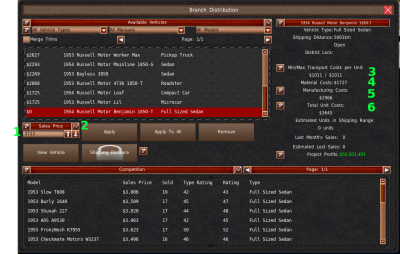Video Tutorials
Pricing Your Vehicle
Pricing your models is critical to the success of your company. The game provides several costs metrics throughout the Branch Distribution window and the reports system. This page will cover mostly the data in the Branch Distribution window since it has all you need to price your vehicles for success.
You can find a video covering the Total Unit Costs and Manufacturing Costs on the video tutorial page or on Youtube. While in-game, please use the in-game video tutorials page.
Branch Distribution Window
The branch distribution window contains most of the information you'll need to properly price a vehicle. You have to visit this window anyway to set prices.
Upon selecting an unsold vehicle from the vehicle list, the game will enter a recommended price into the pricing textbox (#1). The game generates this recommended price with a fixed margin rate over the material costs, and it does not consider any other variables.
You can open the wealth distribution and buyer rating table report at any time using the chart button (#2). This report will generate based on sell price values entered into the sales textbox (#1). We highly recommended that you learn how to use this report. And you should use it when setting the price and sales expectations of your vehicle. For more information see the wealth distribution and buyer rating table report page.
On the right column are metrics about the selected model. The topmost entry pertains to costs is the “Min/Max Transport Costs per Unit” (#3). This value is the minimum and maximum values you'll pay to transport vehicles to this branch when you sell them. The higher the sale price and the closer the branch is to a factory, the higher the branch's priority is for that model.
Next is the vehicle's Material Costs (#4). This value is the base cost of the selected vehicle. This value only covers the materials of the car and does not account for anything else in its production. This number should be the basis of your pricing. You should use other numbers as guides or indicators.
Manufacturing Costs (#5) consist of the Material Costs plus expenses associated with the manufacturing of the model. The value includes fixed labor and factory costs. The more vehicles you produce, the less effect fixed costs will have per unit, thus driving down this value.
Total Unit Costs (#6) are the Manufacturing Costs plus all other company expenses per unit. This value is any expenses your company occurs, divided by the number of vehicles you produce, added to your Manufacturing Costs. These expenses include all branches, marketing, RnD, racing, construction costs, etc. The more vehicles you produce, the lower these costs will be per unit. See the Total Delivery Cost report for a more accurate representation of last month's Total Costs per Vehicle.
The Manufacturing Costs and Total Unit Costs will fluctuate based on company expenditures and the number of vehicles you produce. We highly recommend that you DO NOT raise your price to these numbers. If you raise your prices, you will cause less demand. When there is less demand, you will produce fewer vehicles, and that will cause these two metrics to increase. Instead, look for ways to lower these metrics by either reducing expenses or increasing production.
Instead, you should use the Material costs as the basis for pricing your vehicle and verify against the Wealth Demographics report to maximize the number of revenues you'll receive. With low-volume designs, you'll typically want to sell them at 100% of the material costs or higher. For high-volume models, values around 30-50% work well. After running a turn, you will need to adjust prices and try to work out a balance, as we cover on the Supply and Demand page. In general, you'll want to use the Manufacturing and Total Unit Costs data as profitability metrics. If you try to increase prices to these levels, you will sell fewer vehicles, which will cause you to make fewer vehicles. If you produce fewer vehicles, these cost metrics increase, leading to a death spiral. Instead, increasing production will cause these values to lower, making your vehicles more profitable.

